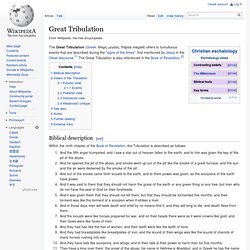

Future of an expanding universe. Global catastrophic risk. A global catastrophic risk is a hypothetical future event with the potential to inflict serious damage to human well-being on a global scale.[2] Some such events could destroy or cripple modern civilization.
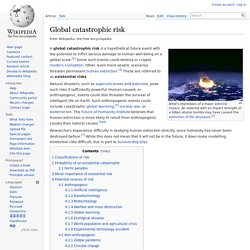
Other, even more severe, scenarios threaten permanent human extinction.[3] These are referred to as existential risks. Natural disasters, such as supervolcanoes and asteroids, pose such risks if sufficiently powerful. Human-caused, or anthropogenic, events could also threaten the survival of intelligent life on Earth. Such anthropogenic events could include catastrophic global warming,[4] nuclear war, or bioterrorism. The Future of Humanity Institute believes that human extinction is more likely to result from anthropogenic causes than natural causes.[5][6] Classifications of risk[edit] Scope/intensity grid from Bostrom's paper "Existential Risk Prevention as Global Priority"[8] Bostrom identifies four types of existential risk. Post-tribulation rapture. In Christian eschatology, the post-tribulation rapture doctrine is the belief in a combined resurrection and rapture (e.g., resurrection-rapture) of all believers coming after the Great Tribulation.
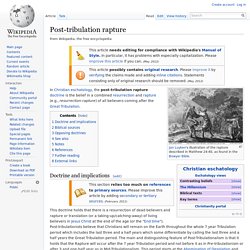
Doctrine and implications[edit] This doctrine holds that there is a resurrection of dead believers and rapture or translation (or a taking-up/catching-away) of living believers in Jesus Christ at the end of the age (or the "End time"). Post-tribulationists believe that Christians will remain on the Earth throughout the whole 7 year Tribulation period which includes the last three and a half years which some differentiate by calling the last three and a half years the Great Tribulation period. The main and distinguishing feature of Post-Tribulationalism is that it holds that the Rapture will occur after the 7 year Tribulation period and not before it as in Pre-tribulationism or after 3 and one-half year as in Mid-Tribulationalism. They came to life, and reigned with Christ a thousand years. End time. End time (also called end times, end of time, end of days, last days, final days, or eschaton) is a time period described in the eschatologies of the dominant world religions, both Abrahamic and non-Abrahamic.

The non-Abrahamic faiths have more cyclical eschatologies regarding end time, characterized by decay, redemption and rebirth. In Hinduism, end time is foretold as when Kalki, the final incarnation of Vishnu, descends atop a white horse and brings an end to the current Kali Yuga. In Buddhism, the Buddha predicted that his teachings would be forgotten after 5,000 years, followed by turmoil. A bodhisattva named Maitreya will appear and rediscover the teaching of dharma. The ultimate destruction of the world will then come through seven suns.
Second Coming. Greek icon of Second Coming, c.1700 In Christianity, the Second Coming, sometimes called the second advent of Christ or the parousia, is the anticipated return of Jesus to Earth.
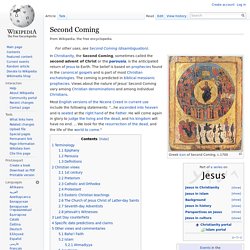
The belief is based on prophecies found in the canonical gospels and is part of most Christian eschatologies. The coming is predicted in biblical messianic prophecies. Views about the nature of Jesus' Second Coming vary among Christian denominations and among individual Christians. Doomsday cult. Some researchers believe that the use of the term by the government and the news media can lead to a self-fulfilling prophecy, in which actions by authorities reinforces the apocalyptic beliefs of the group, which in turn can inspire further controversial actions.
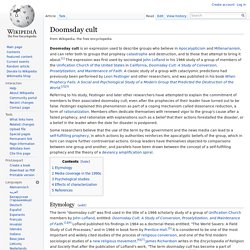
Group leaders have themselves objected to comparisons between one group and another, and parallels have been drawn between the concept of a self-fulfilling prophecy and the theory of a deviancy amplification spiral. The beast (Revelation) La Bête de la Mer (from the Tapisserie de l'Apocalypse in Angers, France).
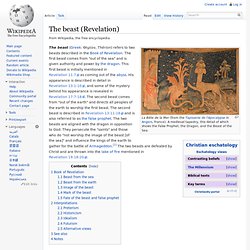
Near-death experience. Characteristics[edit] Researchers have identified the common elements that define near-death experiences.[24] Bruce Greyson argues that the general features of the experience include impressions of being outside one's physical body, visions of deceased relatives and religious figures, and transcendence of egotic and spatiotemporal boundaries.[25] Many different elements have been reported, though the exact elements tend to correspond with the cultural, philosophical, or religious beliefs of the person experiencing it: The traits of a classic NDE are as follows: The notice of unpleasant sound or noise (claimed by R.

Moody).[10]A sense/awareness of being dead.[24][26]A sense of peace, well-being and painlessness. Six Ages of the World. Day-year principle. Biblical basis[edit] Proponents of the principle, such as the Seventh-day Adventists, claim that it has three primary precedents in Scripture:[3] Numbers 14:34.

The Israelites will wander for 40 years in the wilderness, one year for every day spent by the spies in Canaan.Ezekiel 4:5-6. The prophet Ezekiel is commanded to lie on his left side for 390 days, followed by his right side for 40 days, to symbolize the equivalent number of years of punishment on Israel and Judah respectively.Daniel 9:24-27. List of dates predicted for apocalyptic events. Wikipedia list article Predictions of apocalyptic events that would result in the extinction of humanity, a collapse of civilization, or the destruction of the planet have been made since at least the beginning of the Common Era.[1] Most predictions are related to Abrahamic religions, often standing for or similar to the eschatological events described in their scriptures.
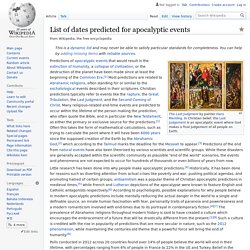
Christian predictions typically refer to events like the rapture, the Great Tribulation, the Last Judgment, and the Second Coming of Christ. Polls conducted in 2012 across 20 countries found over 14% of people believe the world will end in their lifetime, with percentages ranging from 6% of people in France to 22% in the US and Turkey. Past predictions[edit] First millennium CE[edit] 11th–15th centuries[edit] 16th century[edit] 17th century[edit] 18th century[edit] Great Tribulation. The Great Tribulation (Greek: θλίψις μεγάλη, thlipsis megalē) refers to tumultuous events that are described during the "signs of the times", first mentioned by Jesus in the Olivet discourse.[1] The Great Tribulation is also referenced in the Book of Revelation.[2] Biblical description[edit] Within the ninth chapter of the Book of Revelation, the Tribulation is described as follows: Views of the Tribulation[edit] Futurist view[edit] According to Dispensationalists who hold the futurist view, the Tribulation is thought to occur before the Second Coming of Jesus and during the End Times.
